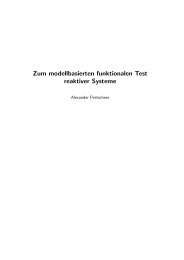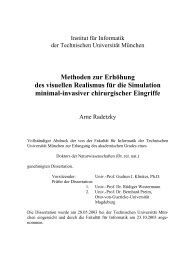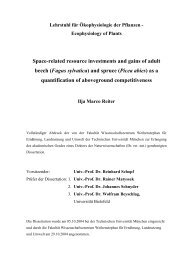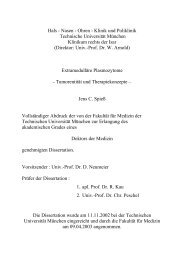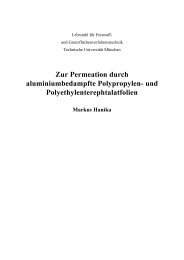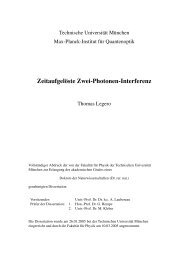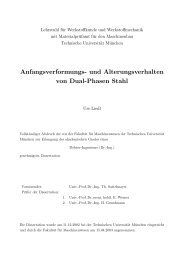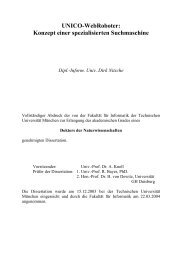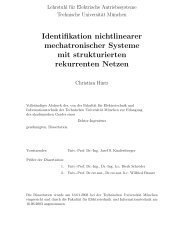Topologically Defined Neuronal Networks Controlled by Silicon Chips
Topologically Defined Neuronal Networks Controlled by Silicon Chips
Topologically Defined Neuronal Networks Controlled by Silicon Chips
You also want an ePaper? Increase the reach of your titles
YUMPU automatically turns print PDFs into web optimized ePapers that Google loves.
CHAPTER 2. NETWORKS OF DEFINED TOPOGRAPHY<br />
Substrate adsorbed material (SAM): This method is based on the adhesive properties of the trophic<br />
factors that adhere very well to poly-L-lysine coated substrates, forming a robust layer of growthpromoting<br />
proteins [79, 124]. Lymnaea brains are incubated directly in the culture chamber at 2brains/ml<br />
medium for 72h. Before plating the neurons, the brains are removed and the supernatant is either diluted<br />
1:1 or completely replaced <strong>by</strong> defined medium. The growth factors attached to the bottom of the<br />
chamber are sufficient to promote vigorous neurite outgrowth.<br />
Layers of SAM are also used to grow topologically defined networks with a technique described in<br />
2.3.1. However, SAM is incompatible with extracellular recording <strong>by</strong> transistors. The adsorbed proteins<br />
form a cushion on the chip surface, there<strong>by</strong> increasing the distance between transistor and neuron,<br />
obstructing a successful neuron-silicon coupling.<br />
Co-culture: The drawbacks of the aforementioned methods can be avoided if neurons and brains are<br />
cultured together, with the ganglionic rings added after the neurons are plated. This allows the neurons<br />
to adhere tightly to the uncovered sticky poly-L-lysine coated surface of the substrate, while the growth<br />
factors are delivered directly to the medium without any loss. As no proteins are present at the time<br />
neurons are placed and secretion starts only after brains are added to the medium, neuronal outgrowth<br />
is delayed for about one day compared to the other methods. The overall success of the co-culture is<br />
not affected <strong>by</strong> this.<br />
2.2.3 Cleaning of substrates<br />
Before neurons were plated, the substrates had to be cleaned, sterilized and coated with poly-L-lysine.<br />
The two latter steps, being rather simple, are described in appendix A, whereas cleaning is discussed<br />
here since it turned out to be problematic. It must be aggressive enough to reliably remove tissue and<br />
debris from previous cell cultures, yet mild enough so as not to affect the substrates. As substrates became<br />
more sophisticated, the demands on the cleaning procedure increased as revealed <strong>by</strong> the following<br />
list:<br />
Glass coverslips: Round cover glasses (diameter 30mm, thickness 1, Assistent) were treated with<br />
acidic and alkaline detergent in an ultrasonic cleaner at 80 ◦ C according to a procedure adapted from<br />
[34] (for details see appendix A). The coverslips were only used once.<br />
Substrates with topographic structures: Topographic structures consist of polyimide or SU-8 polyester<br />
photoresist processed onto glass coverslips and oxidized silicon wafers, see subsection 2.3.2. Due<br />
to internal stress and a different thermal expansion coefficient than the underlying substrate, the resist<br />
layers peel off upon prolonged sonication and temperature shocks. To meet these new requirements,<br />
the previously described procedure was modified. While the time the substrates were immersed in the<br />
detergents was not altered, the temperature was reduced to 50 ◦ C and the overall sonication time was<br />
limited to 5min. Preheated water was used for rinsing to avoid thermal shock. The method allowed<br />
substrates to be recycled five times before the resist began to peel off, but was efficient enough to reliably<br />
remove tissue and dirt in the pits and grooves of the topographic structures.<br />
Transistor chips: Transistor chips are rather complex devices with many different materials (SiO2,<br />
polyester resist, silicone adhesive and PMMA) exposed to the cell culture and thus to subsequent cleaning.<br />
For a detailed description of the chips refer to subsection 3.3.2 and fig. 3.6.<br />
Without the topographic structures, removal of tissue and debris would be easy; mild detergent and<br />
Q-tips for a slight scrubbing are sufficient for conventional chips [49]. However, feature sizes down<br />
to 14µm render the mechanical cleaning of the chips here difficult. There are no brushes with bristles<br />
that fit in the narrow grooves. Methods solely based on chemical treatment are problematic though,<br />
because they either are too aggressive to the device or the results are not satisfactory, with impurities<br />
14


